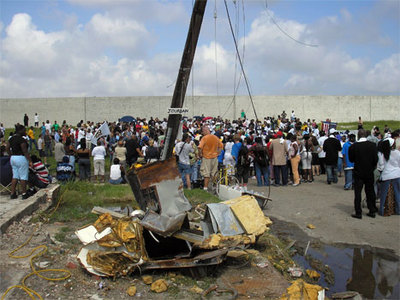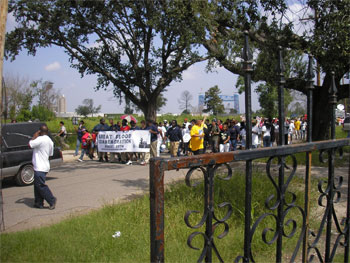On August 29 at 9:38 AM, the time of first breach of the levees during Hurricane Katrina, bells rang out at various points around the city of New Orleans to commemorate the one-year anniversary of the disaster. As the result of the hurricane and the flooding caused by massive levee failure, nearly 1600 people from Louisiana died, in addition to over 300 from other states.
After a year, most of New Orleans is still in ruins and the majority of the population remains scattered in exile. Most schools and hospitals are still closed and most of the city has no electricity. There has been some work on levees; however, the Corps of Engineers concedes that the city could not withstand another major hurricane without significant flooding. A disaster much greater than Katrina remains a possibility in the case of a larger storm or a direct hit.
This August 29 there was much to commemorate in New Orleans and much to ponder as we look to the future.
The most important grassroots event on the anniversary of the disaster was the Great Flood Commemoration March, which began in the city’s devastated Lower Ninth Ward and ended at Congo Square, near the French Quarter in the center of the city. Perhaps a thousand people participated in various stages of the March. It began in front of the point of the large breach in the Industrial Canal levee that caused a torrential surge that swept away or washed off their foundations hundreds of houses and devastated a large part of the Lower Ninth Ward.
The ceremony at the canal wall included singing, dancing, prayers, and a reading of a list of names of the dead. The procession was led by a hearse and after a quiet beginning was joined by a band and turned into a traditional New Orleans jazz funeral, with second lining-dancing by the throng behind the band-mixing mourning with joyous celebration of hope for the future.
The emphasis of the march was on the commemoration of tragedy and loss; however, the call for justice was exhibited in many signs, banners and t-shirts.
The Lower Ninth Ward has come to symbolize most powerfully the injustices of Katrina. It was an overwhelmingly black neighborhood which, though primarily poor, had a high rate of home ownership, a strong sense of community, and a central place in the culture of the city. It was noted as the home of famed New Orleans musician Antoine “Fats” Domino. Music fans have long made pilgrimages to his house, where he still lived until the hurricane. After a year, most of the neighborhood remains almost empty, evidence of destruction is everywhere, and few homes have electricity or other basic services.
After Katrina, some public officials and planners suggested that certain areas “such as the Lower Ninth Ward” should not be rebuilt at all. This neighborhood is, however, generally of higher elevation than middle and upper-middle class neighborhoods such as Gentilly and Lakeview. In view of such geographical realities, such suggestions were transparently based not on concerns for the danger of flooding but rather on a developing program of ethnic and class cleansing.
With growing evidence of such targeting of the neighborhood and the ongoing neglect for its recovery, the Lower Ninth Ward has become the symbol of discriminatory treatment in New Orleans.
One of the accompanying images is entitled “A Neighborhood of Insects and Grass.” This title comes from a chapter in Jonathan Schell’s classic book on nuclear war, The Fate of the Earth, in which he describes an imagined America after a nuclear holocaust as “A Republic of Insects and Grass.” Along Jourdan Road, next to the Industrial Canal breach, where many square blocks of homes were entirely washed away, grass and other vegetation has entirely taken over during the past year. The immediate neighborhood has indeed been abandoned to the insects and grass. This is not some post-apocalyptic scenario, but rather an existing reality.
We might add that the neighborhood has been left also to the ghosts-for there are a few haunting reminders of the previous human inhabitants. An example is the gate pictured in one of the images. It stands eerily at the edge of an open, grass-covered field, leading from nowhere to nowhere. As I looked at it, it occurred to me that this gate was a good symbol for the present plight of several hundred thousand mostly black, mostly poor New Orleanians.
Over six months ago the state’s “Louisiana Recovery Authority” released a plan “to provide opportunities for residents to get back into their homes and help re-establish their lives in Louisiana.” The plan was called “The Road Home.” For so many of our citizens, like those of the Lower Ninth Ward, the plans of the politicians, the planners, and the real estate developers have been instead a “Road to Nowhere.”
The Great Flood Commemorative March was a ceremony of mourning for those who lost their lives, their homes and personal possessions, and their way of life. It was also a protest against the injustices that have been inflicted on so many citizens of New Orleans and a demand for the restoration of our devastated and displaced communities.
I’ve got no time for talkingI’ve got to keep on walkingNew Orleans is my homeThat’s the reason why I’m goin’Yes, I’m walking to New Orleans
— Fats Domino, “Walking to New Orleans”




